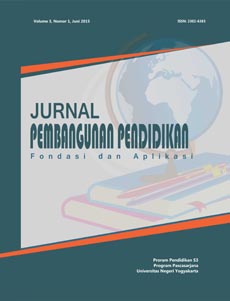Computer Based Instruction (CBI)-flipped classroom development in learning: The experts' validity
DOI:
https://doi.org/10.21831/jppfa.v9i1.37322Keywords:
Computer Based Instruction, CBI, flipped classroom, experts' validityAbstract
References
Amaral, L. A., & Meurers, D. (2011). On using intelligent computer-assisted language learning in real-life foreign language teaching and learning. ReCALL, 23(1), 4–24. https://doi.org/10.1017/S0958344010000261
Bergmann, J., & Sams, A. (2012). Flip your classroom: Reach every student in every class every day. International Society for Technology in Education.
Berrett, D. (2012). How "˜flipping' the classroom can improve the traditional lecture. The Chronicle of Higher Education. https://www.chronicle.com/article/how-flipping-the-classroom-can-improve-the-traditional-lecture/
Collins, A., & Halverson, R. (2009). Rethinking education in the age of technology: The digital revolution and schooling in America. Teachers College Press.
Crompton, H., Burke, D., Gregory, K. H., & Gräbe, C. (2016). The use of mobile learning in science: A systematic review. Journal of Science Education and Technology, 25(2), 149–160. https://doi.org/10.1007/s10956-015-9597-x
Dori, Y. J., & Dori, D. (1994). Object-process analysis of intelligent computer assisted instruction shell: The polymer couseware--A case in point. Proceeding of Educational Multimedia and Hypermedia, 172–177. https://files.eric.ed.gov/fulltext/ED388239.pdf
García-Pérez, R., Santos-Delgado, J.-M., & Buzón-García, O. (2016). Virtual empathy as digital competence in education 3.0. International Journal of Educational Technology in Higher Education, 13(1), 30. https://doi.org/10.1186/s41239-016-0029-7
Hawkins, R. O., Collins, T., Hernan, C., & Flowers, E. (2016). Using computer-assisted instruction to build math fact fluency: An implementation guide. Intervention in School and Clinic, 52(3), 141–147. https://doi.org/10.1177/1053451216644827
Hayadi, B. H., Rukun, K., Wulansari, R. E., Herawan, T., Dahliyusmanto, D., Setaiwan, D., & Safril, S. (2017). Expert system of quail disease diagnosis using forward chaining method. Indonesian Journal of Electrical Engineering and Computer Science, 5(1), 2017–2214. https://doi.org/10.11591/ijeecs.v5.i1.pp206-213
Jia, J., Chen, Y., Ding, Z., Bai, Y., Yang, B., Li, M., & Qi, J. (2013). Effects of an intelligent web-based English instruction system on students' academic performance. Journal of Computer Assisted Learning, 29(6), 556–568. https://doi.org/10.1111/jcal.12016
Kablan, Z., & Erden, M. (2008). Instructional efficiency of integrated and separated text with animated presentations in computer-based science instruction. Computers & Education, 51(2), 660–668. https://doi.org/10.1016/j.compedu.2007.07.002
Kenna, D. C. (2014). A study of the effect the flipped classroom model on student self-efficacy [North Dakota State University]. https://www.proquest.com/openview/0af03254b3da6ab455d72c4e2f5f5bae/1?pq-origsite=gscholar&cbl=18750
Klentien, U., & Wannasawade, W. (2016). Development of blended learning model with virtual science laboratory for secondary students. Procedia - Social and Behavioral Sciences, 217, 706–711. https://doi.org/10.1016/j.sbspro.2016.02.126
Overmyer, G. R. (2014). The flipped classroom model for college algebra: Effects on student achievement [Colorado State University]. https://www.proquest.com/openview/2f27692152ccdae6efdd6d8a9e0e8d1b/1?pq-origsite=gscholar&cbl=18750
Rahayu, L. P. (2017). Efektivitas strategi pembelajaran flipped classroom pada materi pythagoras SMP Kelas VIII ditinjau berdasarkan gender. Prosiding SI MaNIs (Seminar Nasional Integrasi Matematika Dan Nilai-Nilai Islami), 1(1), 173–177. http://conferences.uin-malang.ac.id/index.php/SIMANIS/article/view/57
Rey, M. A. T. (2018). Pengembangan media pembelajaran mata pelajaran komputer dan jaringan dasar kelas X program keahlian teknik Komputer jaringan di SMKN 2 Blitar [Universitas Negeri Malang]. http://repository.um.ac.id/46394/
Rosen, Y. (2009). The effects of an animation-based on-line learning environment on transfer of knowledge and on motivation for science and technology learning. Journal of Educational Computing Research, 40(4), 451–467. https://doi.org/10.2190/EC.40.4.d
Sakti, R. H., Sukardi, S., Giatman, M., Nazar, E., Wakhinuddin, W., & Waskito, W. (2020). Flipped classroom-computer based instruction untuk pembelajaran pada revolusi industri 4.0: Rancang bangun dan analisis kebutuhan. Edumatic : Jurnal Pendidikan Informatika, 4(1), 63–72. https://doi.org/10.29408/edumatic.v4i1.2074
Sukardi, S., Puyada, D., Wulansari, R. E., & Yanto, D. T. P. (2017). The validity of interactive instructional media on electrical circuits at vocational high school and technology. Proceeding of the 2nd INCOTEPD, 123–126. https://eprints.uny.ac.id/58200/1/INCOTEPD101-1.pdf
Usmeldi, U. (2016). Pengembangan modul pembelajaran fisika berbasis riset dengan pendekatan scientific untuk meningkatkan literasi sains peserta didik. JPPPF (Jurnal Penelitian Dan Pengembangan Pendidikan Fisika), 2(1), 1–8. https://doi.org/10.21009/1.02101
VojtoviÄ, S., Navickas, V., & Gruzauskas, V. (2016). Strategy of sustainable competitiveness: Methodology of real-time customers' segmentation for retail shops. Journal of Security & Sustainability Issues, 5(4), 489–499. https://doi.org/10.9770/jssi.2016.5.4(4)
Downloads
Published
How to Cite
Issue
Section
Citation Check
License
The Authors submitting a manuscript do so on the understanding that if accepted for publication, copyright publishing of the article shall be assigned to Jurnal Pembangunan Pendidikan: Fondasi dan Aplikasi
 | Jurnal Pembangunan Pendidikan: Fondasi dan Aplikasi by https://journal.uny.ac.id/index.php/jppfa is licensed under a Creative Commons Attribution-ShareAlike 4.0 International License. |















